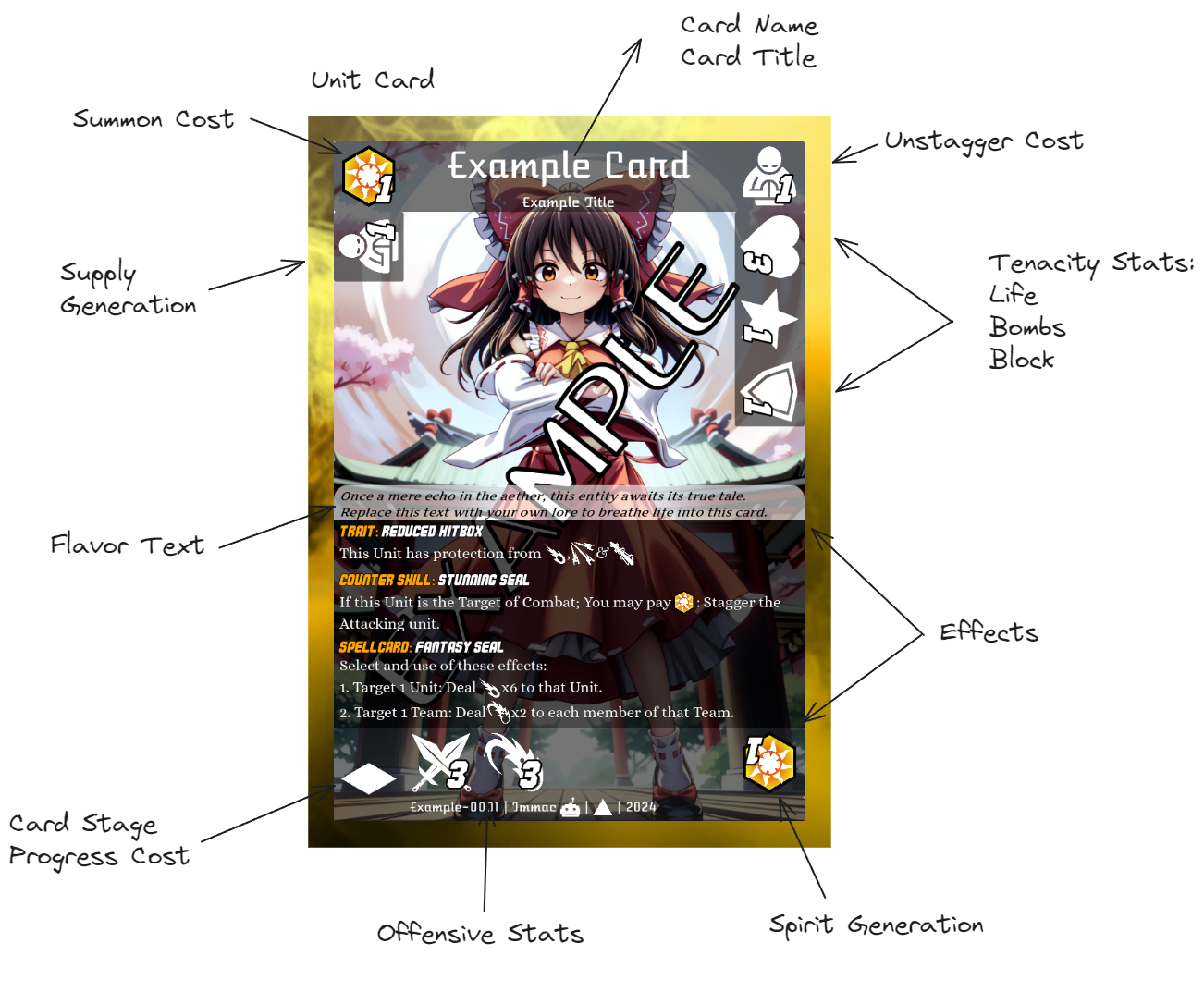Touhou Spirit Clash
This Documentation is a work in progress,
thank you for your consideration.
Rules and Game Mechanics
Objective: All Stage Clear
The objective of the game is to Clear 7 of your Opponent’s Stages, 6 Main Stages and 1 Extra Stage. Each Player takes turns, developing their board and Knocking Out opposing Units, as well as completing Objectives in order to Clear Stages. Be careful though, each Stage that is Cleared grants the Player with access to more resources and options.
Setup
To play the game you will need a deck composed of at least 50 Cards and a most 60 Non-Location Cards, this is your Main Deck. You will need a second deck of 12 Location Cards, this is your Locations Deck. You may have up to 4 copies of cards with the same Name on each deck.
To start, set the Main Deck and the Locations Deck on the designated Zone in the [Play Area]. Use a fair random method to choose which player will play first. Each player draws 5 Cards, then the Game Starts following the [Game Flow Chart] for each player.
What is in a card?

Playing a Card
Cards come in the following Card Types:
- Unit Cards: Characters and creatures that players can deploy onto the Battlefield, they usually interact with each other via Combat or with the game state via Effects. Ally Units may Team Up to form a Team, more on this later.
- Item Cards: Items and inanimate objects, they can be placed on the field and used by Units by attaching them to the Unit or Team. They perfom on, or add Effects to the Unit or Team.
- Spellcard Cards: Spellcards perform effects listed on them.
- Stage Cards: Stage Cards denote what Stage your opponent is currently trying to Clear. Stage cards may have Effects that impact the whole board, and grow more powerful in the later Stages. Stage cards have their own separate Deck.
Note: At the moment of writting there is plans for
Unit, Item, Spellcard and Location cards.
Each player has a battle field, refer to the following picture for explanations.

In order to play a card, the card’’s cost must be payed from yout Spirit Power, at least one of the Spirit Power used to pay must be of the same Element. More on Spirit Charging in the turn order section. Once the Cost is paid, you may play the card.
The following chart describes how the turns are played.
Combat
Combat Types
During the Battle Phase, the Active Player targets one of their Teams and an opposing Player’s Team to start a battle. Enter Battle can be activated at this moment. Combat is divided into Ranged Combat (,
,
,
) and Melee Combat (
,
,
), each starting with a priority of 0. Card Effects can alter this priority. The Combat type with the highest priority is performed first. If priorities are tied at the start of the Duel Step, the current Player decides which Combat type occurs first. If both Units lack the Stats to perform a Combat Phase, that Phase is skipped.
Melee Combat
When melee combat is initiated, you first calculate advantage, then any Card Effects that can be activated during the Duel Step are activated, priority of activation starts with the current Player.
The table below explains the effectiveness of different Melee combat types against each other. Essentially, a unit’s Melee stat will double when fighting an opponent with a combat style it is strong against.
| Name | Icon | Target | (2x) VS |
|---|---|---|---|
| Fighter | Single, Leader | ||
| Wielder | Single, Leader | ||
| Grappler | Single, Leader |
Example:
Grappler vs. Wielder:
- When a Grappler battles an Wielder, the Grappler’s Melee Stat will double.
Ranged Combat
Cards can deal the following Types of damage. Damage can be avoided with Block or
Graze in accordance to the chart below.
| Name | Icon | Target | Block? | Graze? |
|---|---|---|---|---|
| Direct | Single, Leader | |||
| Spread | Team | |||
| Homing | Single, Any | |||
| Piercing | Team |
- Describe the core gameplay mechanics:
- How are cards played?
- What are the win conditions?
- Any special rules or interactions?
- Explain turn structure, phases, and actions.
Deck Building
- Guide players on constructing their decks:
- Deck size
- Card limits
- Card ratios (characters, spells, etc.)
- Sideboards (if applicable)
Gameplay Examples
- Walk through sample turns or scenarios.
- Illustrate how cards interact with each other.
Card Abilities and Keywords
(Spirit Trait: A Trait that is active when this Card exists in your Spirit Zone) (Trait: A Skill whose activation and effect cannot be negated)
- List common abilities (e.g., “Flying,” “Counter,” “Charge,” etc.).
- Explain their effects and how they impact gameplay.
Artwork and Flavor
- Showcase card art and flavor text.
- Discuss the thematic elements inspired by the Touhou universe.
Tournaments and Events
- If applicable, provide information on organized play:
- Tournaments
- Prizes
- Community events
FAQ and Troubleshooting
- Address common player questions.
- Troubleshoot issues related to rules or gameplay.
Conclusion
- Summarize the key points.
- Encourage players to explore the game further.